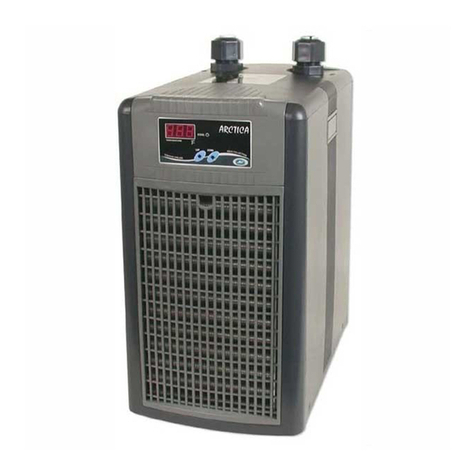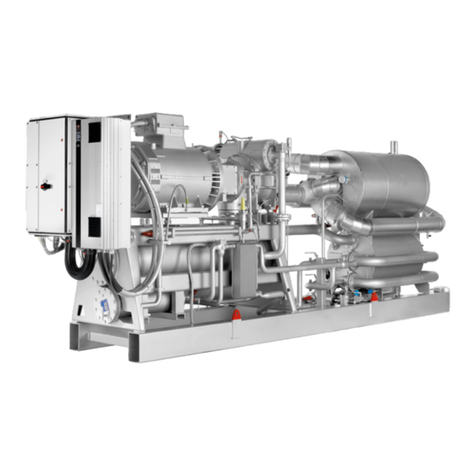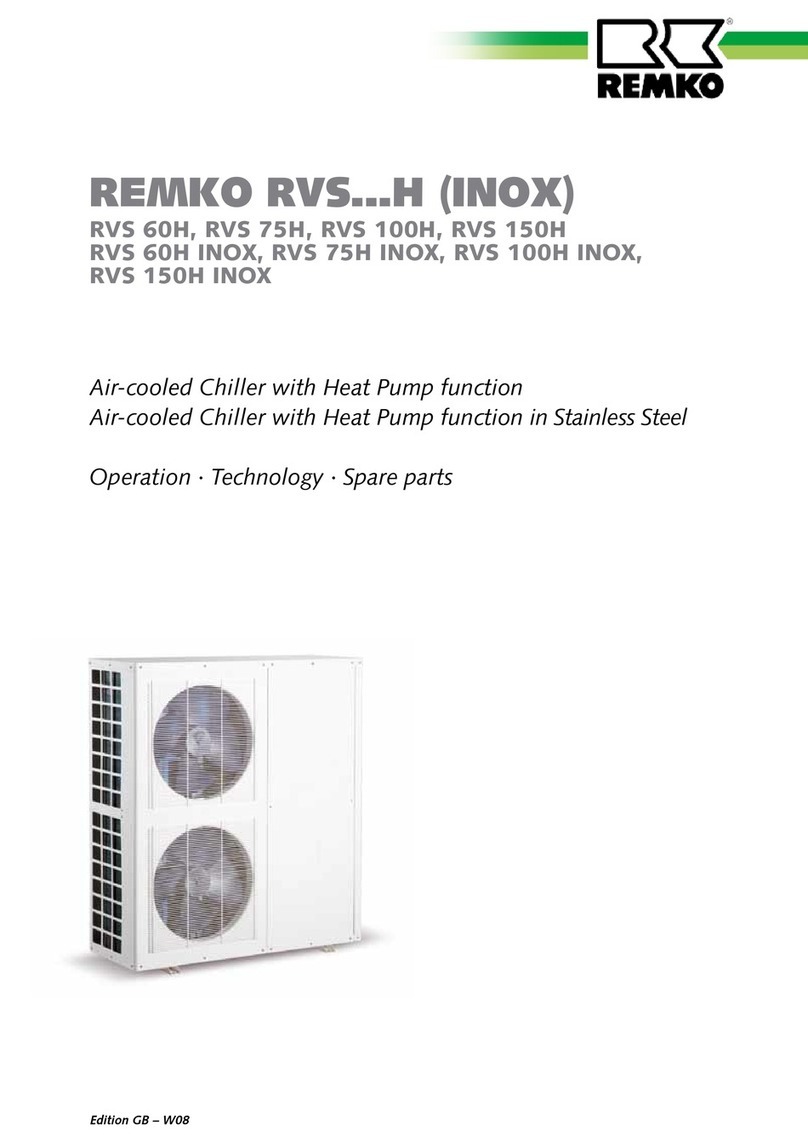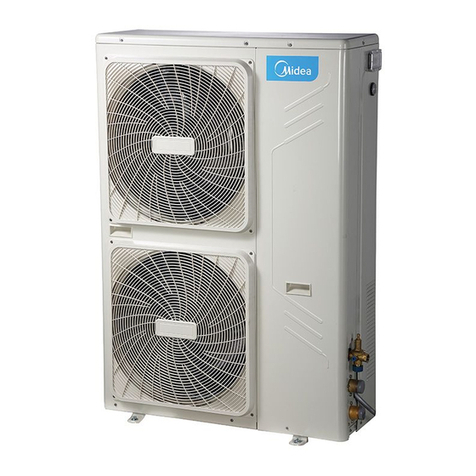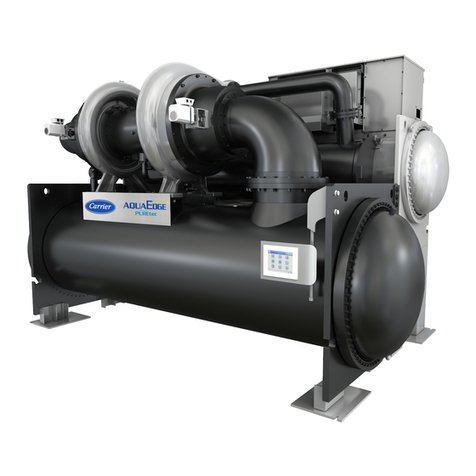ROBUA GA Line ACF Series Service manual

Installation, Use and
Maintenance Manual
GA Line ACF Series
Natural gas/LPG red
Gas red absorption chiller

Revision: M
Code: D-LBR357
This Manual has been drawn up and printed by Robur S.p.A.; whole or partial reproduction of this manual is
forbidden.
The original is led at Robur S.p.A.
Any use of this manual other than for personal consultation must be previously authorised by Robur S.p.A.
The rights of those who have legitimately led the registered trademarks contained within this publication are not
aected.
With the aim of continuously improving the quality of its products, Robur S.p.A. reserves the right to modify the
data and contents of this manual without prior notice.

Installation, Use and Maintenance Manual – GA Line ACF Series 3
INDEX OF CONTENTS
I INTRODUCTION...............................................4
II SYMBOLS AND DEFINITIONS.........................4
II.1 Key to symbols......................................................................4
II.2 Terms and denitions.........................................................4
III WARNINGS.......................................................4
III.1 General and safety warnings...........................................4
III.2 Conformity .............................................................................6
III.3 Exclusions of liability and warranty...............................6
1 FEATURES AND TECHNICAL DATA ................6
1.1 Features...................................................................................6
1.2 Size............................................................................................7
1.3 Components....................................................................... 10
1.4 Electrical wiring diagram ............................................... 13
1.5 Electronic boards .............................................................. 14
1.6 Controls ................................................................................ 15
1.7 Technical characteristics................................................. 16
2 TRANSPORT AND PLACEMENT ...................17
2.1 Warnings.............................................................................. 17
2.2 Handling............................................................................... 17
2.3 Appliance positioning..................................................... 18
2.4 Minimum clearance distances...................................... 18
2.5 Mounting base................................................................... 19
3 PLUMBING INSTALLER .................................19
3.1 Warnings.............................................................................. 19
3.2 Plumbing system .............................................................. 19
3.3 Hydraulic connections .................................................... 20
3.4 Water circulation pump.................................................. 21
3.5 Antifreeze function........................................................... 21
3.6 Antifreeze liquid................................................................ 21
3.7 System water quality ....................................................... 21
3.8 Water system lling.......................................................... 22
3.9 Combustible gas supply................................................. 22
4 ELECTRICAL INSTALLER ...............................23
4.1 Warnings.............................................................................. 23
4.2 Electrical systems.............................................................. 23
4.3 Electrical power supply................................................... 24
4.4 Adjustment and control ................................................. 25
4.5 Water circulation pump.................................................. 27
5 FIRST SWITCH ON..........................................28
5.1 Preliminary checks............................................................ 28
6 ROUTINE OPERATION...................................29
6.1 Warnings.............................................................................. 29
6.2 Switch on and o.............................................................. 29
6.3 Signals on the display...................................................... 29
6.4 Electronic adjustment on the machine – Menus
and parameters of the S61 board............................... 29
6.5 Modifying settings............................................................ 31
6.6 Restarting a locked-down unit – Reset..................... 31
6.7 Eciency.............................................................................. 32
7 MAINTENANCE..............................................32
7.1 Warnings.............................................................................. 32
7.2 Pre-emptive maintenance............................................. 32
7.3 Scheduled routine maintenance................................. 32
7.4 Periods of inactivity.......................................................... 33
8 DIAGNOSTICS................................................33
8.1 Operative codes................................................................. 33
APPENDICES........................................................35
1 Declaration of Conformity............................................. 35

I Introduction
4
I INTRODUCTION
Manual
This Manual is an integral part of the GA unit and must
be handed to the end user together with the appliance.
Recipients
This Manual is intended for:
▶
end user, for appropriate and safe use of the appliance;
▶
qualied installer, for correct appliance installation;
▶
designer, for specic information on the appliance.
Control device
In order to be able to work, the GA-ACF unit needs a control de-
vice (DDC or external request), which must be connected by the
installer.
II SYMBOLS AND DEFINITIONS
II.1 KEY TO SYMBOLS
DANGER
WARNING
NOTE
PROCEDURE
REFERENCE (to other document)
II.2 TERMS AND DEFINITIONS
GA Appliance/Unit = equivalent terms, both used to designate
the GA Gas Absorption chiller.
TAC = Technical Assistance Centre authorised by Robur.
External request = generic control device (e.g. thermostat, tim-
er or any other system) equipped with a voltage-free NO contact
and used as control to start/stop the GA unit.
DDC Control (Direct Digital Controller) = optional Robur device
to control one or more Robur appliances (GAHP heat pumps, GA
chillers and AY boilers) in ON/OFF mode.
RB100/RB200 Devices (Robur Box) = optional interface devices
complementary to DDC, which may be used to broaden its func-
tions (heating/cooling/DHW production service demands, and
control of system components such as third party generators,
adjustment valves, circulating pumps, probes).
GUE (Gas Utilization Eciency) = eciency index of gas chiller,
equal to the ratio between the chilling energy produced and the
energy of the fuel used (relative to NCV, net caloric value).
First Switch-On = appliance commissioning operation which
may only and exclusively be carried out by a TAC.
S61 Board = electronic board on the GA unit, to control all func-
tions and to provide interface with other devices and with the
user.
III WARNINGS
III.1 GENERAL AND SAFETY WARNINGS
Installer's qualications
Installation must exclusively be performed by a Quali-
ed Firm and by Skilled Personnel, with specic knowl-
edge on heating, cooling, electrical systems and gas
appliances, pursuant to the laws in force in the Country
of installation.
Workmanlike Conformity Declaration
Upon completing installation, the installing rm shall is-
sue to the owner/principal the appliance'sWorkmanlike
Conformity Declaration, according to national/local reg-
ulations in force and the manufacturer's instructions/
provisions.
Misuse
The appliance must only be used for the purposes for
which it has been designed. Any other use is deemed
hazardous. Incorrect use may aect operation, duration
and safety of the appliance. Adhere to the manufactur-
er's instructions.
Hazardous situations
▶
Do not start the appliance in hazardous conditions,
such as: gas smell, problems with the hydraulic/elec-
trical/gas system, parts of the appliance under water
or damaged, malfunctioning, disabling or bypassing
control and safety devices.
▶
In case of danger, request assistance by skilled
personnel.
▶
In case of danger, switch o the electrical power and
gas supplies only if this can be done in total safety.
▶
Do not entrust children,personswith physical,senso-
ry or mental disabilities or persons with poor knowl-
edge and experience with use of the appliance.
Gas component seal

III Warnings
Installation, Use and Maintenance Manual – GA Line ACF Series 5
▶
Before performing any operation on gas ducting
components, close the gas cock.
▶
Upon completing any procedure, perform the leak
test according to regulations in force.
Gas smell
If you smell gas:
▶
Do not use electrical devices such as telephones,
multimeters or other equipment that may cause
sparks next to the appliance.
▶
Shut o the gas supply by turning the cock o.
▶
Disconnect electrical power supply by means of the
external isolation switch in the power supply electri-
cal panel.
▶
Use a telephone away from the appliance to ask for
assistance from skilled personnel.
Moving parts
The appliance contains moving parts.
▶
Do not remove guards during operation, and in any
case prior to disconnecting the power supply.
Burn hazard
The appliance contains very hot parts.
▶
Do not open the appliance and do not touch internal
components before the appliance has cooled down.
Pressure vessels
The appliance has a sealed circuit classied as pres-
sure vessel, the tightness of which is tested by the
manufacturer.
▶
Do not carry out any operation on the sealed circuit
or on the appliance's valves.
Water-ammonia solution
The GA unit uses the ammonia-water absorption cycle.
The water-ammonia solution is contained in the sealed
circuit.The solution is harmful for health if it is ingested,
inhaled or comes in contact with the skin.
▶
In the event of coolant leak keep away and discon-
nect the power and gas supply (only if it is possible
to do so with no danger).
▶
Request assistance from the TAC.
Electrocution hazard
▶
Disconnect the electrical power supply before any
work/procedure on appliance components..
▶
For electrical connections exclusively use compliant
components and according to the specications pro-
vided by the manufacturer.
▶
Ensure the appliance cannot be accidentally
switched back on.
Earthing
Electrical safety depends on eective earthing system,
correctly connected to the appliance and installed ac-
cording to the regulations in force.
Distance from combustible or ammable materials
▶
Do not store ammable materials (paper, solvents,
paint, etc.) in the vicinity of the appliance.
Scale and corrosion
Depending on the chemical-physical features of the
system water, scale or corrosion may damage the appli-
ance (Paragraph 3.7p.21).
▶
Check system sealing.
▶
Avoid frequent top-ups.
Chloride concentration
The concentration of chlorides or free chlorine in the
system water must not exceed the values in Table
3.2p.22.
Aggressive substances in air
Halogenated hydrocarbons containing chlorine and
uorine compounds cause corrosion. The supply/venti-
lation air of the appliance must be free from aggressive
substances.
Switching the appliance o
Disconnecting the power supply while the appliance
is running may cause permanent damage to internal
components.
▶
Except in the case of danger, do not disconnect the
power supply to switch o the appliance, but always
and exclusively act through the control device pro-
vided (DDC or external enable).
In the event of failure
Operations on internal components and repairs may
exclusively be carried out by a TAC, only using original
parts.
▶
In the event of failure of the appliance and/or break-
age of any component, do not attempt to repair and/
or restore and immediately contact the TAC.
Routine maintenance
Proper maintenance assures the eciency and good
operation of the appliance over time.
▶
Maintenance must be performed according to the
manufacturer's instructions (see Chapter 7 p. 32)
and in compliance with current regulations.
▶
Appliance maintenance and repairs may only be
entrusted to rms legally authorised to work on gas
appliances and systems.
▶
Enter into a maintenance contract with an author-
ised specialised rm for routine maintenance and for
servicing in case of need.
▶
Only use original parts.

1 Features and technical data
6
Decommissioning and disposal
If the appliance is to be disposed of, contact the manu-
facturer for its disposal.
Store the Manual
This "Installation, Use and Maintenance Manual" must
always accompany the appliance and must be hand-
ed to the new owner or installer in the event of sale or
removal.
III.2 CONFORMITY
EU Directives and standards
GA series absorption chillers are certied in compliance to EC
standards and conform with the essential requirements of the
following Directives:
▶
2009/142/EC "Gas Appliances Directive" as amended and
added.
▶
2004/108/EC "Electromagnetic Compatibility Directive" as
amended and added.
▶
2006/95/EC "LowVoltage Directive" as amended and added.
▶
2006/42/EC "Machine Directive" as amended and added.
▶
97/23/EEC "Pressure Equipment Directive" as amended and
added.
Furthermore, they comply with the requirements of the follow-
ing standards:
▶
EN 378 Refrigerating systems and heat pumps.
Other applicable provisions and standards
The design, installation, operation and maintenance of the sys-
tems shall be carried out in compliance with current applicable
regulations, depending on the Country and location, and in ac-
cordance with the manufacturer's instructions. In particular, reg-
ulations regarding the following shall be complied with:
▶
Gas systems and equipment.
▶
Electrical systems and equipment.
▶
Heating and air conditioning systems, and chillers.
▶
Fire safety and prevention.
▶
Any other applicable law, standard and regulation.
III.3 EXCLUSIONS OF LIABILITY AND
WARRANTY
Any contractual or extra-contractual liability of the
manufacturer for any damage caused by incorrect in-
stallation and/or improper use and/or failure to comply
with regulations and with the manufacturer's direc-
tions/instructions shall be disclaimed.
In particular, the warranty on the appliance may be ren-
dered void by the following conditions:
▶
Incorrect installation.
▶
Misuse.
▶
Failure to comply with the manufacturer's indica-
tions on installation, use and maintenance.
▶
Alteration or modication of the product or any part
thereof.
▶
Extreme operational conditions or however out-
side of the operational ranges set forth by the
manufacturer.
▶
Damages caused by external agents such as salts,
chlorine, sulphur or other chemical substances con-
tained in the installation water or present in the air of
the installation site.
▶
Abnormal actions transmitted by the plant or instal-
lation to the appliance (mechanical stresses, pres-
sure, vibrations, thermal dilations, power surges...).
▶
Accidental damages or due to force majeure.
1 FEATURES AND TECHNICAL DATA
1.1 FEATURES
Operation
Based on the thermodynamic water-ammonia absorption cycle
(H20–NH3), the appliance produces chilled water using natural
gas (or LPG) as primary energy source and dissipating heat di-
rectly to the external air.
The thermodynamic cycle takes place within a hermetically
sealed circuit, in welded construction, perfectly tight, facto-
ry-tested, which does not require any maintenance or coolant
top-ups.
Mechanical and thermo-hydraulic components
▶
steel sealed cooling circuit, externally treated with epoxy
paint;
▶
Multigas premix burner equipped with ignition and ame
detection device, controlled by an electronic controller;
▶
titanium stainless steel shell-and-tube water exchanger
(evaporator), externally insulated;
▶
air exchanger (condenser) with nned coil, with steel pipe
and aluminium ns;
▶
helical fan motor with variable ow controlled by micro pro-
cessor.
Control and safety devices
▶
S61 electronic board with microprocessor, LCD display and
knob;
▶
circuit water ow switch;
▶
manually reset generator limit thermostat;
▶
automatically resettable ue gas thermostat;
▶
dierential air pressure switch on the combustion circuit;
▶
sealed circuit safety relief valve;
▶
by-pass valve, between high and low pressure circuits;
▶
ionisation-based ame controller;
▶
gas solenoid valve with double shutter;
▶
heat recovery exchanger circulating pump relay (HR version
only)
ACF-HR/TK/HT/LB Versions
The GA unit is available in the following versions:

1 Features and technical data
Installation, Use and Maintenance Manual – GA Line ACF Series 7
▶
ACF standard, for residential/retail/industrial cooling sys-
tems with chilled water up to +3 °C.
▶
HR with heat recovery exchanger, for residential/retail/in-
dustrial cooling systems with chilled water up to +3 °C, plus
recovery exchanger hot water up to +80 °C (e.g. DHW pro-
duction);
▶
TK for heavy duty use, for process systems and applications
with chilled water up to +3 °C, in continuous operation year
round;
▶
HT for very hot climates, for residential/retail/industrial cool-
ing systems with chilled water up to +5 °C, with outside air
up to +50 °C;
▶
LB for negative temperatures, for cooling systems with
chilled water up to -10 °C (glycol indispensable).
Models ACF, TK, LB and HT have 2 chilled water inlet/outlet t-
tings, model HR has 4 chilled water and heat recovery exchanger
hot water inlet/outlet ttings.
Each version may be supplied with standard (STD) or silenced
(S) fan.
1.2 SIZE
Figure 1.1 – GA-ACF standard version dimensions

1 Features and technical data
8
Figure 1.2 – GA-ACF silenced version dimensions
Figure 1.3 – ACF Service plate with plumbing and gas connections
LEGEND
A WATER FLOW TO INSTALLATION 1"1/4 F
B WATER INLET TO UNIT 1"1/4 F
G GAS SUPPLY 3/4" F

1 Features and technical data
Installation, Use and Maintenance Manual – GA Line ACF Series 9
Figure 1.4 – ACF-HR Service plate with plumbing and gas connections
LEGEND
G GAS SUPPLY 3/4" F
Chiller - CHILLED WATER
D WATER FLOW TO INSTALLATION 1"1/4 F
C WATER INLET TO UNIT 1"1/4 F
Recovery exchanger - HOT WATER
A WATER FLOW TO INSTALLATION 1"1/4 F
B WATER INLET TO UNIT 1"1/4 F

1 Features and technical data
10
1.3 COMPONENTS
Figure 1.5 – Internal components - front view
LEGEND
1.Combustion air intake
2.Blower
3. Gas valve
4.Electrical Panel
5.Oil pump
6.Water inlet connection Ø 1"1/4 F
7.Water ow connection Ø 1"1/4 F
8.Gas connection
9.Ambient temperature probe
10.Fan

1 Features and technical data
Installation, Use and Maintenance Manual – GA Line ACF Series 11
Figure 1.6 – Left side internal components
LEGEND
1.Ignition transformer
2.Flue gas thermostat
3.Ignitor and ame detectors

1 Features and technical data
12
Figure 1.7 – Right side internal components
LEGEND
1.Safety valve
2.Manual air vent
3.Inlet temperature probe
4.TG Probe
5.Limit thermostat
6.Flow temperature probe
7.Water ow switch
8.Teva Probe

1 Features and technical data
Installation, Use and Maintenance Manual – GA Line ACF Series 13
1.4 ELECTRICAL WIRING DIAGRAM
Figure 1.8 – GA-ACF, ACF-TK, ACF-LB, ACF-HT Unit wiring diagram
LEGEND
TER 230Vac power supply terminal block
SCH electronic board (S61)
GV gas solenoid valve
LS gas ow warning lamp
PSW air pressure switch
THMF outlet water temperature probe
THRF inlet water temperature probe
TCN condenser outlet temperature probe
TA ambient air temperature probe
TG condenser inlet temperature probe
SRT1 oil pump rotation sensor
TF exhausted gas thermostat
TL generator limit thermostat (manual
reset)
FL water ow switch
BLW blower motor
C blower condenser
FAN fan motor
C2 fan condenser
PMP oil hydraulic pump motor
PWRTR transformer 230/24 Vac
CNTBOX ame control unit
IGN ignition electrodes
IGNTR ignition transformer
FLS detection electrode

1 Features and technical data
14
Figure 1.9 – GA-ACF-HR Unit wiring diagram
LEGEND
TER 230Vac power supply terminal board
SCH electronic board (S61)
GV gas solenoid valve
LS gas ow control lamp
PSW air pressure switch
THM outlet water temperature probe
THR inlet water temperature probe
TCN condenser output temperature probe
TA ambient air temperature probe
TG condenser input temperature probe
SRT1 oil pump rotation sensor
TF ue gas thermostat
TL generator limit thermostat (manual
reset)
FL water ow switch
BLW blower motor
C blower capacitor
FAN fan motor
C2 fan capacitor
PMP oil pump motor
PWRTR transformer 230/24 Vac
CNTBOX ame controller
IGN ignitors
IGNTR ignition transformer
FLS ame detector
KP installation water circulating pump
relay (recovery circuit)
1.5 ELECTRONIC BOARDS
The appliance's electrical panel contains:
Electronic Board S61 (Figure 1.10 p. 15), with microproces-
sor, it controls the appliance and displays data, messages and
operative codes. The appliance is monitored and programmed
by interacting with the display and knob.

1 Features and technical data
Installation, Use and Maintenance Manual – GA Line ACF Series 15
Figure 1.10 – Electronic board S61
LEGEND
SCH S61" electronic board
THMF water delivery temperature probe
input
THRF water return temperature probe input
TCN condenser outlet temperature probe
input
TA ambient air temperature probe input
TG generator temperature probe input
(condenser input)
TA1 not used
TA2 not used
SRT1 oil pump rotation sensor input
SRT2 not used
JP12 not used
SPI not used
P8 (GND, L, H) CAN BUS connector
J1 CAN BUS jumper
A1, A2 auxiliary inputs (not used)
TF ue gas thermostat input
TL generator limit thermostat input
FL water ow switch input
FS5 (24V AC) board supply input (SCH) 24
Vac
P7 (R, W, Y, O) operation request inputs
IGN.BOX (L, N) ame controller supply input 230
Vac
MAIN (L, N) board supply input (SCH) 230 Vac
PUMP 230V (L, N) oil hydraulic pump supply
output
N.O. Contact circuit water circulating pump
controller terminals
J10 circuit water circulating pump control-
ler jumper
FAN (BK, WH, BR) fan output
JTAG board programming connector (SCH)
ENC knob
JP10 6-pole ame controller connector
F1 fuse T 2A
F2 fuse F 10A
F3 fuse T 2A
F4 fuse T 3,15A
1.6 CONTROLS
Control device
The appliance may only work if it is connected to a control de-
vice, selected from:
▶
(1) DDC control
▶
(2) external request
1.6.1 Adjustment system (1) with DDC (GAHP unit ON/OFF)
The DDC controller is able to control appliances, a single GA unit,
or even several Robur GAHP/GA/AY units in cascade, only in ON/
OFF mode (non modulating). For more details refer to the DDC,
RB100, RB200 Manuals and the Design Manual.
DDC Controller
The main functions are:
▶
setup and control of one (or more) Robur units of the ab-
sorption line (GAHP, GA, AY);
▶
parameter gures display and setting;
▶
hourly programming;
▶
climate curve control;
▶
diagnostics;
▶
reset errors;
▶
possibility to interface with a BMS;
DDC functionality may be extended with auxiliary Robur devices
RB100 and RB200 (e.g. service requests, DHW production, Third
Party generator control, probe control, system valves or circulat-
ing pumps, ...).

1 Features and technical data
16
1.6.2 Control system (2) with external request
The appliance may also be controlled via generic request de-
vices (e.g. thermostats, clocks, buttons, contactors...) tted with
voltage-free NO contact. This system only provides elementary
control (on/o, with xed set-point temperature), thus without
the important system functions (1). It is advisable to limit its pos-
sible use only to simple applications and with a single appliance.
For connection of the selected device to the appliance's
electronic board please refer to Paragraph 4.4p.25.
1.7 TECHNICAL CHARACTERISTICS
(see Table 1.1p.16).
Table 1.1 – New table
ACF60-00 ACF60-00 HR ACF60-00 TK ACF60-00 HT ACF60-00 LB
THERMAL EFFICIENCIES
OPERATING IN COOLING MODE
Operation point A35 W7 Cooling output kW 17,72 (1)
GUE % 71
Operation point A50 W7 Cooling output kW 17,12 (1)
GUE % 68
Operation point A35
W-5 Cooling output kW 13,3
GUE % 53
Thermal capacity
nominal (1013 mbar
- 15°C) kW 25,3
actual (1005 mbar
- 19°C) kW 25.0
Cold water temperature
(ow) minimum °C 3 (3) 5 -10
nominal °C 7 -5
Cold water temperature
(inlet) maximum °C 45
minimum °C 7,5 -7
Nominal thermal dierential °C 5
Water ow rate
maximum l/h 3200 2900
nominal l/h 2770 2675 2600
minimum l/h 2500 2300
Internal pressure drop at nominal water ow bar 0,29 (2) 0,42 (2)
External air temperature
nominal °C 35
maximum °C 45 50 45
minimum °C 0 -12 0
OPERATING RECOVERY CIRCUIT
Thermal power nominal (1013 mbar
- 15°C) kW 25,3
Cooling capacity (with simultaneous recovery
exchanger) 17,93
HOT WATER TEMPERA-
TURE (INLET) nominal °C 40
HOT WATER TEMPERA-
TURE (OUTLET) nominal °C 58
Water ow rate
maximum l/h 2500
minimum l/h 0
nominal l/h 2180
G.U.E. gas usage eciency (total) % 155
ELECTRICAL SPECIFICATIONS
Power supply
Voltage V 230
TYPE SINGLE PHASE
Frequency 50 Hz
supply 50
Electrical power
absorption nominal kW 0,82 (6) 0,90 (6)
nominal silenced kW 0,87 0.93
Degree of protection IP X5D
INSTALLATION DATA
gas consumption methane G20 (nominal) m3/h 2,68 (3)
GPL G30/G31 (nominal) kg/h 1,97 (4) 1,94 (4)
Sound power Lw (max) dB(A) 82,1 (7)
Sound power Lw (max) silenced dB(A) 76,1 (7)
Sound pressure Lp at 5 metres (max) dB(A) 60,1 (8)
Sound pressure Lp at 5 metres (max) silenced dB(A) 54,1 (8)
Maximum lling pressure bar 3
Maximum water pressure in operation bar 4
Water content inside
the apparatus HOT SIDE l 3
COLD SIDE l 3
Water tting TYPE F
thread " G 1 1/4

2 Transport and placement
Installation, Use and Maintenance Manual – GA Line ACF Series 17
ACF60-00 ACF60-00 HR ACF60-00 TK ACF60-00 HT ACF60-00 LB
Gas tting TYPE F
thread " G 3/4
Size
width mm 850
depth mm 1230
height mm 1290
silenced height mm 1540
Weight In operation kg 360 390 380
Note:
(1) As per standard EN12309-2
(2) For ows other than nominal refer to Planning Manual
(3) PCI (G20) 34.02 MJ/m3 (1013 mbar 15 °C)
(4) PCI (G30/G31) 46.34 MJ/kg (1013 mbar 15 °C).
(6) ± 10% according to the power supply voltage and tolerance on electrical motors
consumption
(7) Sound power values detected in compliance with the intensity measurement
methodology set forth by standard EN ISO 9614.
(8) Maximum sound pressure levels in free eld, with directionality factor 2, ob-
tained from the sound power level in compliance with standard EN ISO 9614.
Table 1.2 – PED data
ACF60-00 ACF60-00 HR ACF60-00 TK ACF60-00 HT ACF60-00 LB
PED data
COMPONENTS UNDER
PRESSURE
Generator l 18,6
Leveling chamber l 11,5
Evaporator l 3,7
Cooling volume
transformer l 4,5
Cooling absorber
solution l 6,3
Solution pump l 3,3
TEST PRESSURE (IN AIR) bar g 55
MAXIMUM PRESSURE OFTHE COOLING CIRCUIT bar g 32
FILLING RATIO kg of
NH3/l 0.173 0,159 0,177 0,157 0,173
FLUID GROUP I°
2 TRANSPORT AND PLACEMENT
2.1 WARNINGS
Damage from transport or installation
The manufacturer shall not be liable for any damage
during appliance transport and installation.
On-site inspection
▶
Upon arrival at the site, ensure there is no transport
damage on packing, metal panels or nned coil.
▶
After removing the packing materials, ensure the ap-
pliance is intact and complete.
Packing
▶
Only remove the packing after placing the appliance
on site.
▶
Do not leave parts of the packing within the reach of
children (plastic, polystyrene, nails...) since they are
potentially dangerous.
Weight
▶
The crane and lifting equipment must be suitable for
the load.
▶
Do not stand under suspended loads.
2.2 HANDLING
Handling and lifting
▶
Always handle the appliance in its packing, as delivered by
the factory.
▶
To lift the appliance use straps or slings inserted in the holes
of the base (Figure 2.1p.18).
▶
Use hanging and spacing rods to avoid damaging the outer
panels and nned coil (Figure 2.1p.18).
▶
Comply with safety regulations at the installation site.

2 Transport and placement
18
Figure 2.1 – Instruction for lifting
In the event of handling with forklift or pallet truck, com-
ply with the handling methods shown on the packing.
2.3 APPLIANCE POSITIONING
Do not install inside a room
The appliance is type-approved for external installation.
▶
Do not install inside a room, not even if it has
openings.
▶
In no event start the appliance inside a room.
GA Unit ventilation
The aerothermal appliance requires a large space, venti-
lated and free from obstacles, to enable smooth ow of
air to the nned coil and free air outlet above the mouth
of the fan, with no air recirculation.Incorrect ventilation
may aect eciency and cause damage to the appli-
ance.The manufacturer shall not be liable for any incor-
rect choices of the place and setting of installation.
Where to install the appliance
▶
The appliance may be installed at ground level, on a terrace
or on a roof, compatibly with its size and weight.
▶
It must be installed outside buildings, in an area of natural air
circulation, outside the dripping path of drainpipes or simi-
lar. It does not require protection from weathering.
▶
No obstruction or overhanging structure (e.g. protruding
roofs, canopies, balconies, ledges, trees) shall interfere either
with the air owing from the top of the appliance or with the
exhaust ue gas.
▶
Do not install near the exhaust of ues, chimneys or hot
polluted air. In order to work correctly, the appliance needs
clean air.
Acoustic issues
▶
Pre-emptively assess the appliance's sound eect in connec-
tion to the site, taking into account that building corners, en-
closed courtyards, restricted spaces may amplify the acous-
tic impact due to the reverberation phenomenon.
2.4 MINIMUM CLEARANCE DISTANCES
Distances from combustible or ammable materials
▶
Keep the appliance away from combustible or ammable
materials or components, in compliance with applicable reg-
ulations.

3 Plumbing installer
Installation, Use and Maintenance Manual – GA Line ACF Series 19
Clearances around the appliance
The minimum clearance distances shown in Figure 2.2p.19
(bar any stricter regulations) are required for safety, operation
and maintenance.
Figure 2.2 – Clearances
2.5 MOUNTING BASE
Mounting base constructive features
▶
Place the appliance on a levelled at surface made of re-
proof material and able to withstand its weight.
(1) - installation at ground level
▶
Failing a horizontal supporting base, make a at and lev-
elled concrete base, at least 100-150 mm larger than the ap-
pliance size per side.
(2) - installation on terrace or roof
▶
The structure of the building must support the total weight
of the appliance and the supporting base.
▶
If necessary, provide a maintenance walkway around the
appliance.
Anti vibration mountings
Although the appliance's vibrations are minimal, resonance
phenomena might occur in roof or terrace installations.
▶
Use anti-vibration mountings.
▶
Also provide anti-vibration connections between the appli-
ance and water and gas pipes.
3 PLUMBING INSTALLER
3.1 WARNINGS
General warnings
Read the warnings in Chapter III p. 4, providing im-
portant information on regulations and on safety.
Compliance with installation standards
Installation must comply with applicable regulations in
force, based on the installation Country and site, in mat-
ters of safety, design, implementation and maintenance
of:
▶
heating/cooling systems and appliances;
▶
gas systems and appliances;
Installation must also comply with the manufacturer's
provisions.
3.2 PLUMBING SYSTEM
Primary and secondary circuit
▶
In many cases it is advisable to divide the hydraulic system
into two parts, primary and secondary circuit, uncoupled by

3 Plumbing installer
20
a hydraulic separator, or possibly by a tank that also acts as
inertial volume/thermal inertia.
Constant water ow rate
The GA unit works with constant, water ow and ON/OFF oper-
ative mode.
System and components must be designed and installed
consistently.
Minimum water content
High thermal inertia is conducive to ecient appliance opera-
tion. Very short ON/OFF cycles are to be avoided.
▶
For each GA unit provide a minimum water content in the
installation of at least 70 litres.
▶
If necessary, provide for an inertial volume, to be suitably
sized (see design manual).
Buer tank
In the event of using a buer tank, this may have 2 or 4 pipes,
as shown in the following two diagrams (Figures 3.1 p. 20
3.2p.20).
Figure 3.1 – 2-pipe tank diagram
Figure 3.2 – 4-pipe tank diagram
3.3 HYDRAULIC CONNECTIONS
Plumbing ttings
on the right, at the bottom, connection plate
Versions ACF/TK/LB/HT (Figure 1.3p.8).
▶
A (= out) 1"1/4 F- chilled WATER OUTPUT (m = ow to the
installation);
▶
B(= in) 1"1/4 F- chilled WATER INPUT (r = inlet from the in-
stallation).
HR Version with heat recovery exchanger (Figure 1.4p.9).
▶
A(= out) 1"1/4 F - chilled WATER OUTPUT (m = ow to the
installation);
▶
B(= in) 1"1/4 F- chilled WATER INPUT (r = inlet from the in-
stallation).
▶
D(= out) 1"1/4 F - WATER OUTPUT (chilled) (m = ow to the
installation);
▶
C(= in) 1"1/4 F - WATER INPUT (r = inlet from the installa-
tion).
Hydraulic pipes, materials and features
▶
Use pipes for heating/cooling installations, protected from
weathering, insulated for thermal losses, with vapour barrier
to prevent condensation.
Pipe cleaning
▶
Before connecting the appliance, accurately clean the water
and gas piping and any other system component, removing
any residue.
Minimum components of primary plumbing circuit
▶
Always provide, near the appliance:
on water piping, both output and input (m/r)
▶
2 ANTIVIBRATION JOINTS on water ttings;
▶
2 PRESSURE GAUGES;
▶
2 BALL VALVES for shutting o;
on the input water piping (r)
▶
1 DIRT SEPARATOR FILTER
▶
1 FLOW REGULATION VALVE;
LEGEND
1 Anti-vibration connection
2 Pressure gauge
3 Flow regulation valve
4 Water lter
5 Shut o valves
6 Water pump (primary circuit)
7 Safety valve (3 bar)
8 Expansion tank
9 Hydraulic separator
10 Water pump (secondary circuit)
11 2-pipe buer tank
LEGEND
1 Anti-vibration connection
2 Pressure gauge
3 Flow regulation valve
4 Water lter
5 Shut o valves
6 Water pump (primary circuit)
7 Safety valve (3 bar)
8 Expansion tank
9 4-pipe buer tank
10 Water pump (secondary circuit)
Table of contents
Popular Chiller manuals by other brands
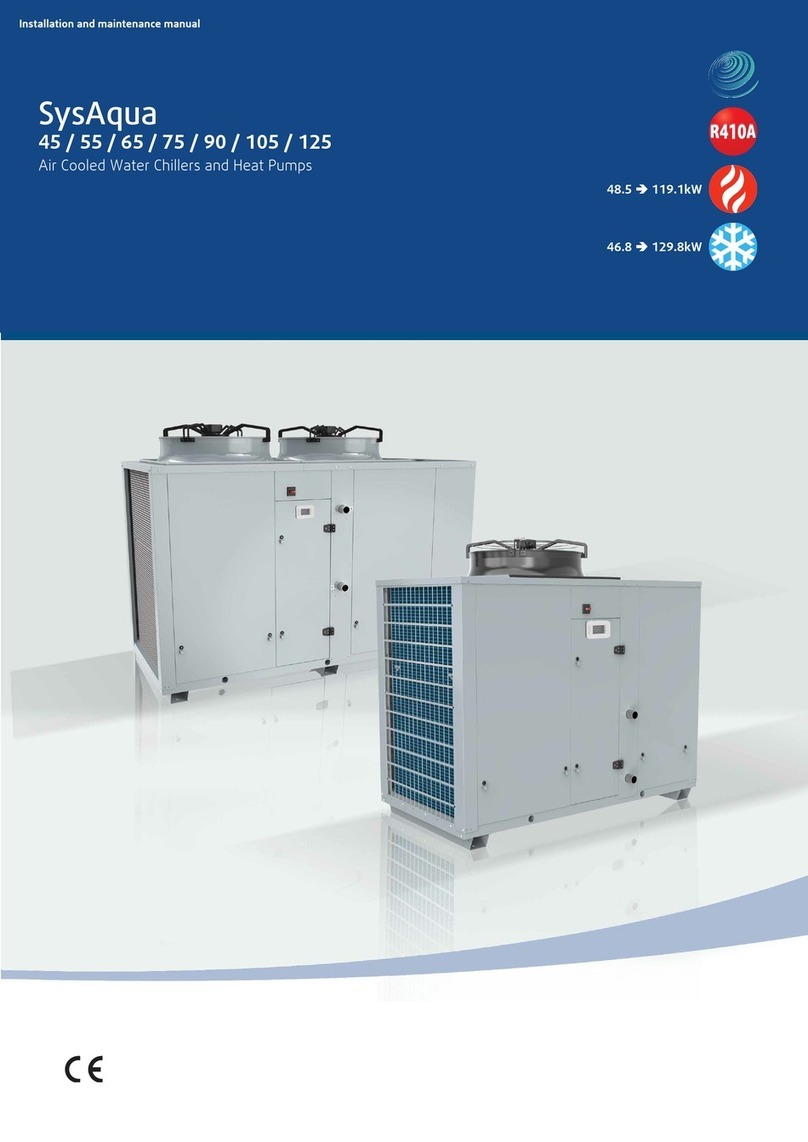
System air
System air SysAqua Series Installation and maintenance manual
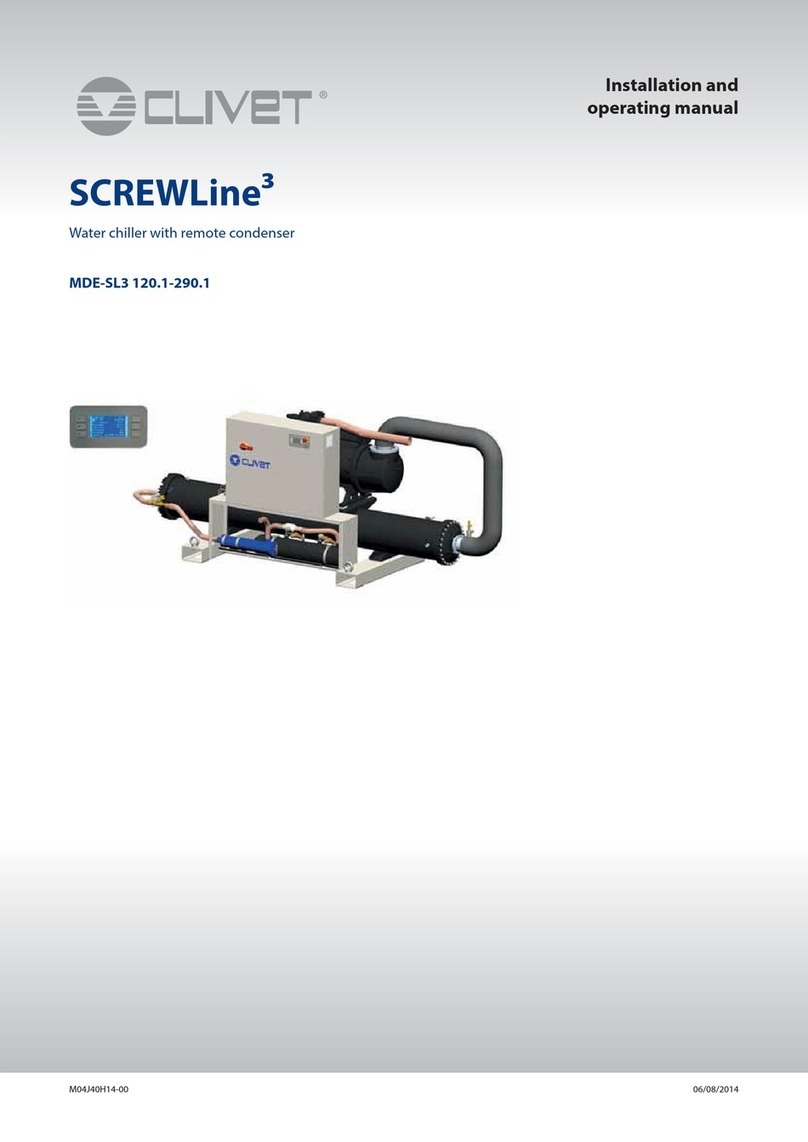
CLIVET
CLIVET SCREWLINE3 MDE-SL3 Series Installation and operating manual
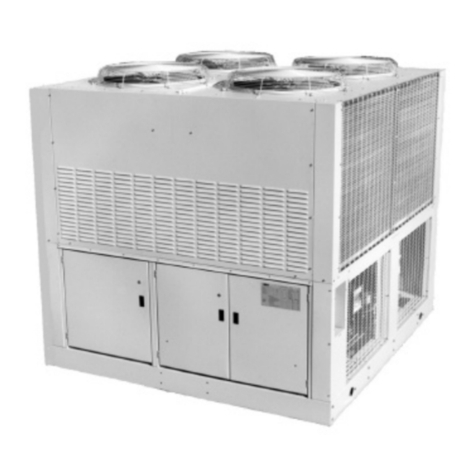
McQuay
McQuay AGZ 030A Installation and operation manual
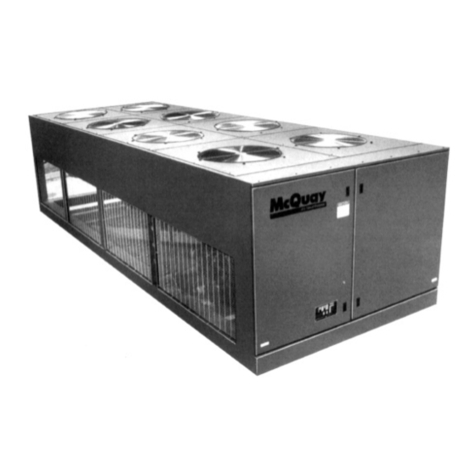
McQuay
McQuay ALR 032E installation manual
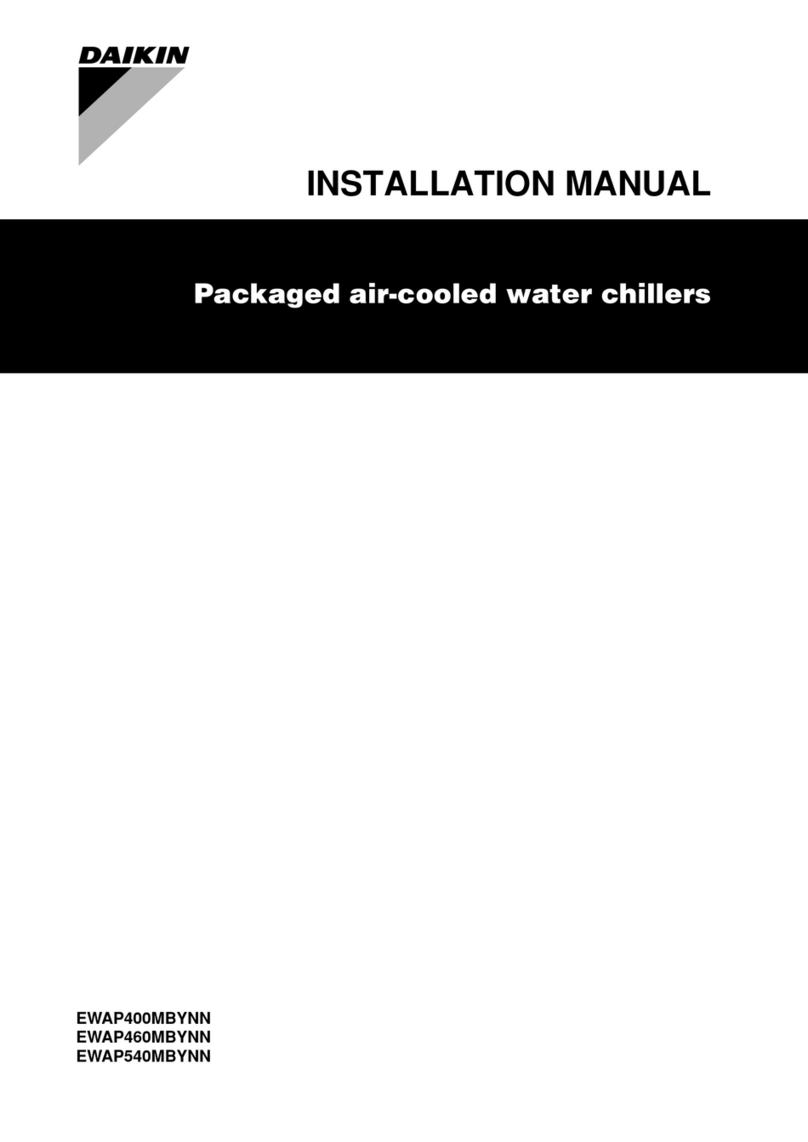
Daikin
Daikin EWAP400MBYNN installation manual
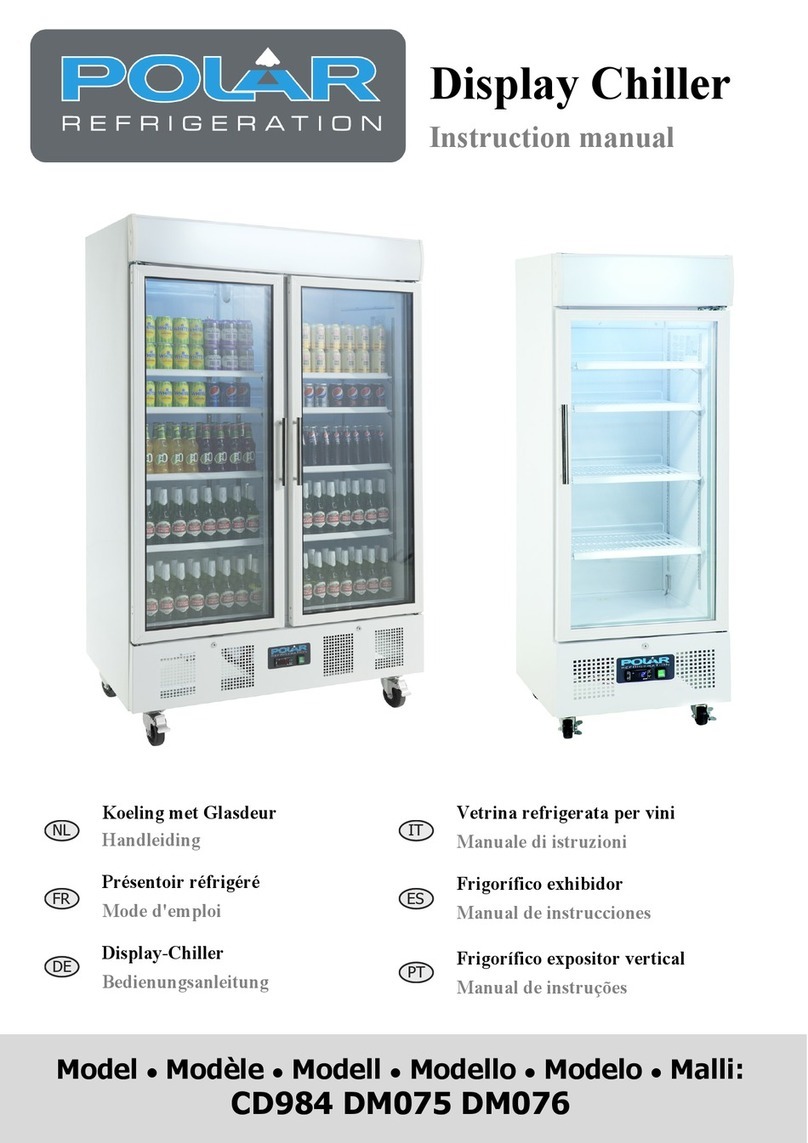
Polar Refrigeration
Polar Refrigeration CD984 instruction manual
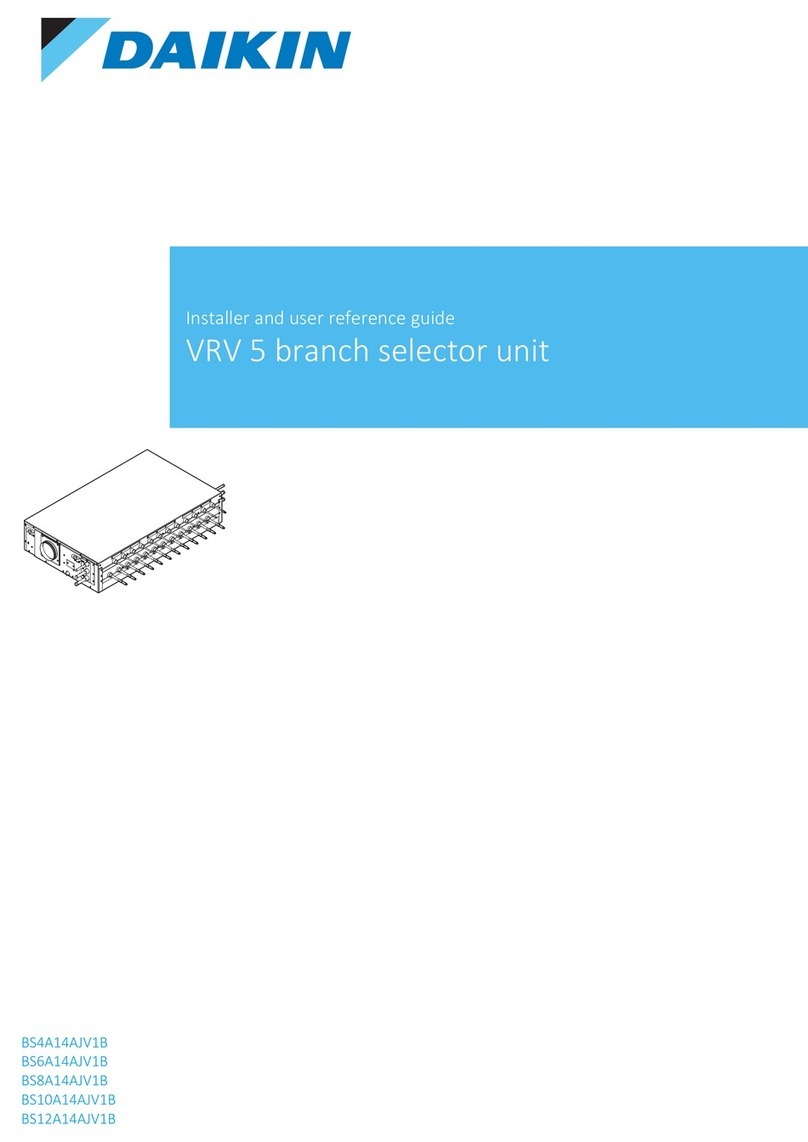
Daikin
Daikin VRV 5 BS4A14AJV1B manual
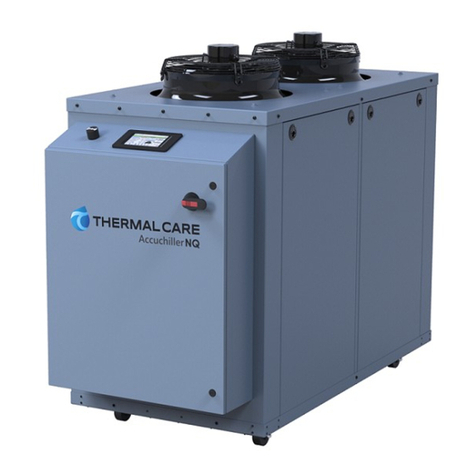
Thermal Care
Thermal Care Accuchiller NQ Series Operation, installation, and maintenance manual
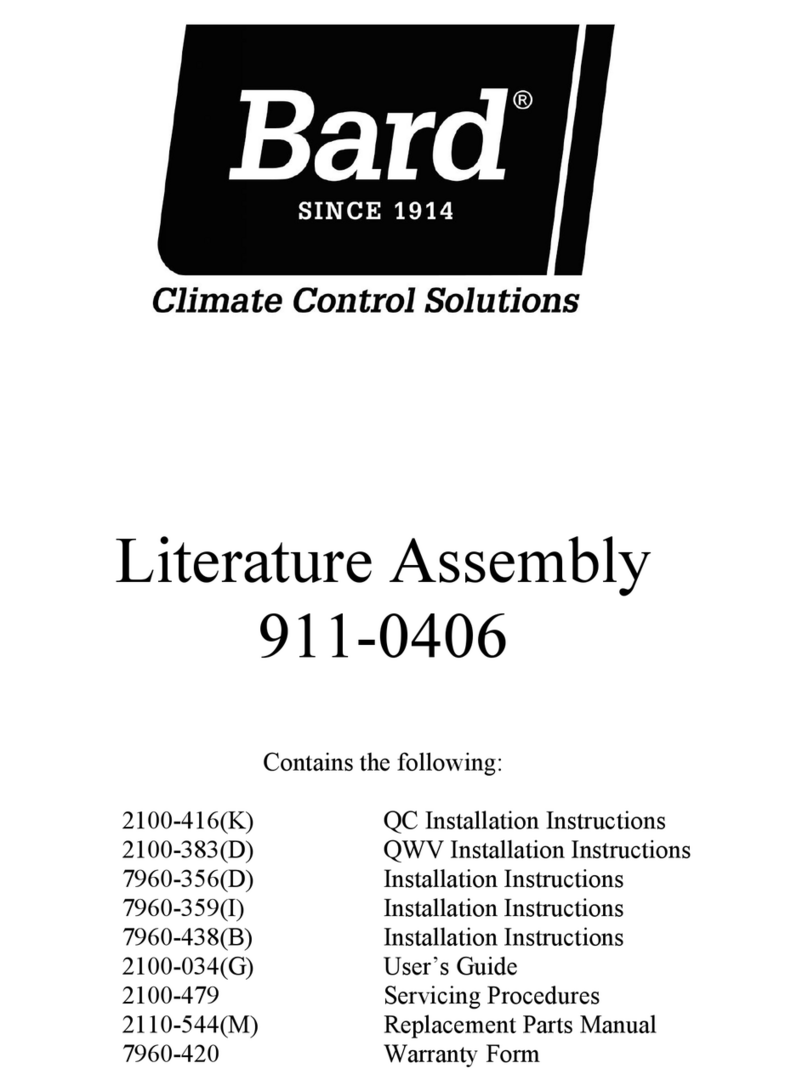
Bard
Bard QC Series installation instructions
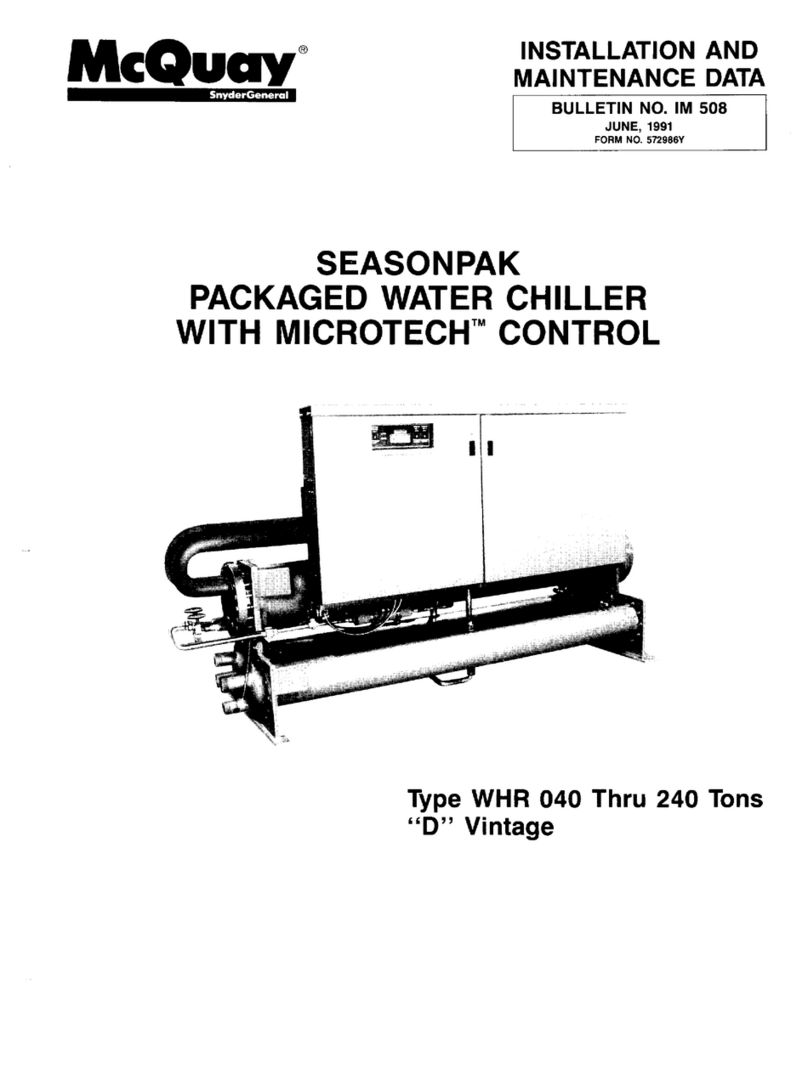
McQuay
McQuay WHR Series Installation and maintenance data
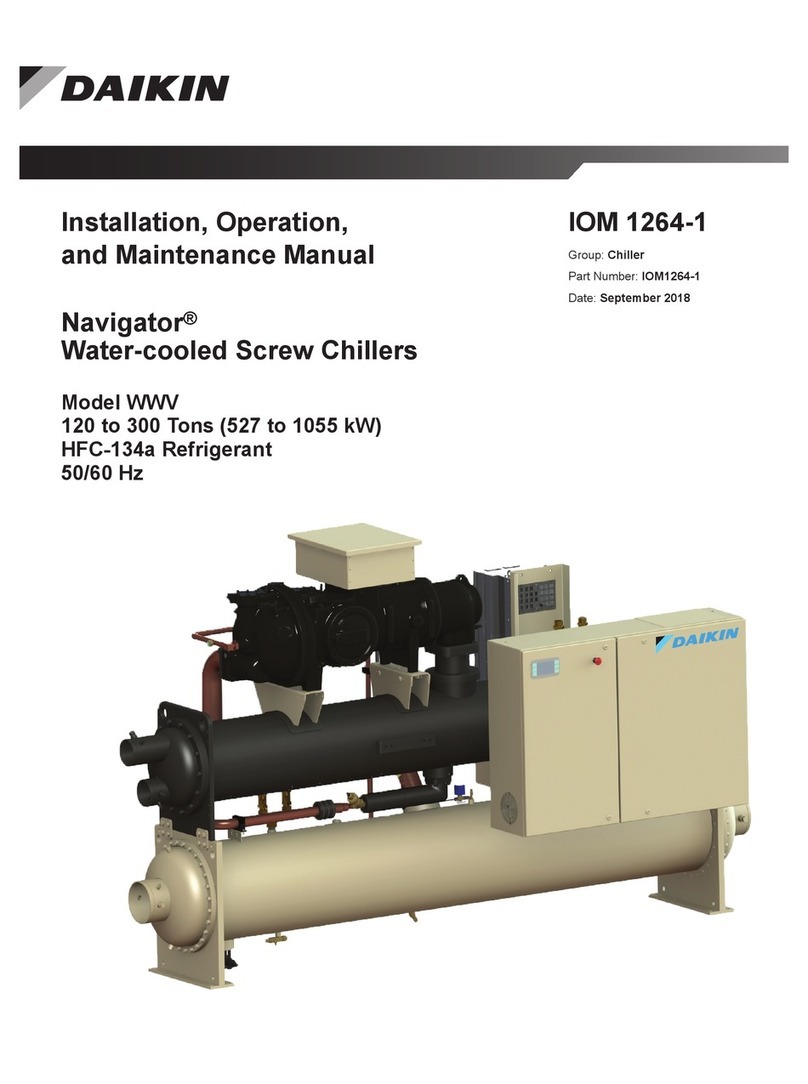
Daikin
Daikin Navigator WWV Installation, operation and maintenance manual
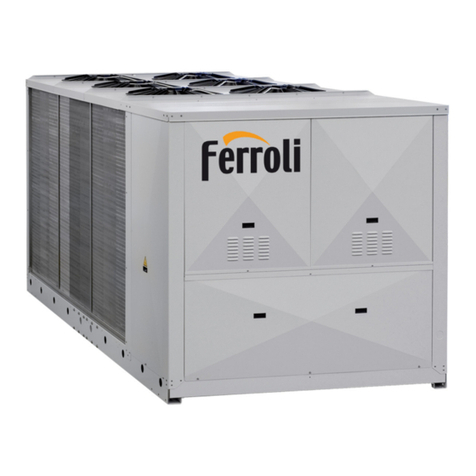
Ferroli
Ferroli RCA Series Installation, maintenance and user manual

